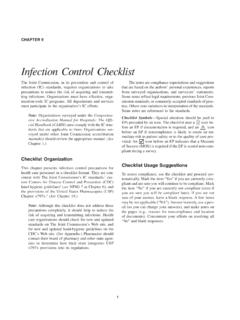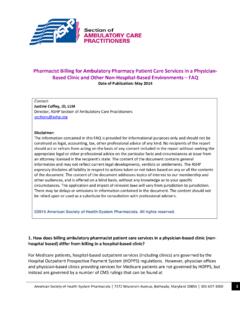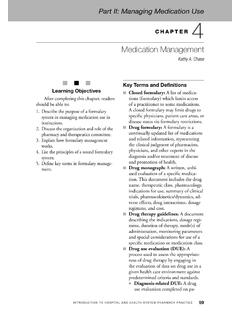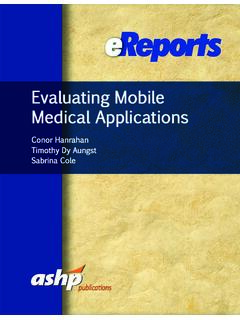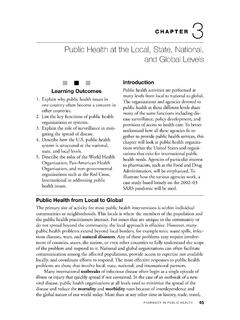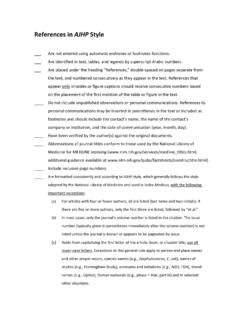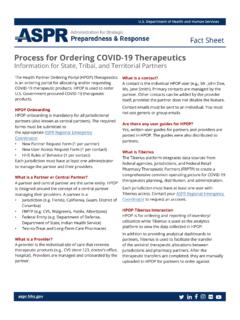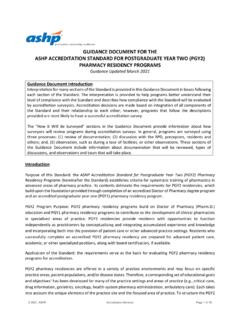Transcription of Introduction to Pharmacokinetics and Pharmacodynamics
1 LESSON. 1. Introduction to Pharmacokinetics and Pharmacodynamics C OBJECTIVES. After completing Lesson 1, you should be able to: 1. De ne and differentiate between Pharmacokinetics 5. Describe situations in which routine clinical phar- and clinical Pharmacokinetics . macokinetic monitoring would be advantageous. 2. De ne Pharmacodynamics and relate it to pharma- 6. List the assumptions made about drug distribution cokinetics. patterns in both one- and two-compartment models. 3. Describe the concept of the therapeutic concentra- 7. Represent graphically the typical natural log of tion range. plasma drug concentration versus time curve for a 4.
2 Identify factors that cause interpatient variability in one-compartment model after an intravenous drug disposition and drug response. dose. Pharmacokinetics is currently defined as the study of the receptor sites for digoxin are thought to be within the time course of drug absorption, distribution, metabo- myocardium. Obviously we cannot directly sample drug lism, and excretion. Clinical Pharmacokinetics is the concentration in this tissue. However, we can measure application of pharmacokinetic principles to the safe drug concentration in the blood or plasma, urine, saliva, and effective therapeutic management of drugs in an and other easily sampled fluids (Figure 1-1).
3 Kinetic individual patient. homogeneity describes the predictable relationship Primary goals of clinical Pharmacokinetics include between plasma drug concentration and concentration at enhancing efficacy and decreasing toxicity of a patient's the receptor site where a given drug produces its thera- drug therapy. The development of strong correlations peutic effect (Figure 1-2). Changes in the plasma drug between drug concentrations and their pharmacologic concentration reflect changes in drug concentrations at responses has enabled clinicians to apply pharmacoki- the receptor site, as well as in other tissues. As the con- netic principles to actual patient situations.
4 Centration of drug in plasma increases, the concentration A drug's effect is often related to its concentration at of drug in most tissues will increase proportionally. the site of action, so it would be useful to monitor this Similarly, if the plasma concentration of a drug is concentration. Receptor sites of drugs are generally inac- decreasing, the concentration in tissues will also cessible to our observations or are widely distributed in decrease. Figure 1-3 is a simplified plot of the drug con- the body, and therefore direct measurement of drug con- centration versus time profile after an intravenous drug centrations at these sites is not practical.
5 For example, the dose and illustrates this concept. 1. 2 Concepts in Clinical Pharmacokinetics FIGURE 1-3. Drug concentration versus time. FIGURE 1-1. BASIC PHARMACODYNAMIC CONCEPTS. Blood is the fluid most often sampled for drug concentration determination. Pharmacodynamics refers to the relationship between drug concentration at the site of action and the resulting effect, including the time course and intensity of thera- The property of kinetic homogeneity is important peutic and adverse effects. The effect of a drug present for the assumptions made in clinical pharmacokinet- at the site of action is determined by that drug's binding ics.
6 It is the foundation on which all therapeutic and with a receptor. Receptors may be present on neurons in toxic plasma drug concentrations are established. That the central nervous system ( , opiate receptors) to is, when studying concentrations of a drug in plasma, depress pain sensation, on cardiac muscle to affect the we assume that these plasma concentrations directly intensity of contraction, or even within bacteria to dis- relate to concentrations in tissues where the disease rupt maintenance of the bacterial cell wall. process is to be modified by the drug ( , the central For most drugs, the concentration at the site of the nervous system in Parkinson's disease or bone in receptor determines the intensity of a drug's effect (Fig- osteomyelitis).)
7 This assumption, however, may not be ure 1-4). However, other factors affect drug response as true for all drugs. well. Density of receptors on the cell surface, the mech- anism by which a signal is transmitted into the cell by CLINICAL CORRELATE. second messengers (substances within the cell), or regu- latory factors that control gene translation and protein production may influence drug effect. This multilevel Drugs concentrate in some tissues because of physi- cal or chemical properties. Examples include digoxin, which concentrates in the myocardium, and lipid- soluble drugs, such as benzodiazepines, which con- centrate in fat.
8 FIGURE 1-4. FIGURE 1-2. Relationship of drug concentration to drug effect at the recep- Relationship of plasma to tissue drug concentrations. tor site. Lesson 1: Introduction to Pharmacokinetics and Pharmacodynamics 3. FIGURE 1-6. Demonstration of tolerance to drug effect with repeated dosing. For some drugs, the effectiveness can decrease with continued use. This is referred to as tolerance. Tolerance may be caused by pharmacokinetic factors, such as increased drug metabolism, that decrease the concen- trations achieved with a given dose. There can also be pharmacodynamic tolerance, which occurs when the same concentration at the receptor site results in a reduced effect with repeated exposure.
9 An example of FIGURE 1-5. drug tolerance is the use of opiates in the management Relationship of drug concentration at the receptor site to of chronic pain. It is not uncommon to find these effect (as a percentage of maximal effect). patients requiring increased doses of the opiate over time. Tolerance can be described in terms of the dose . response curve, as shown in Figure 1-6. regulation results in variation of sensitivity to drug To assess the effect that a drug regimen is likely to effect from one individual to another and also deter- have, the clinician should consider pharmacokinetic mines enhancement of or tolerance to drug effects.
10 And pharmacodynamic factors. Both are important in In the simplest examples of drug effect, there is a rela- determining a drug's effect. tionship between the concentration of drug at the receptor site and the pharmacologic effect. If enough concentra- tions are tested, a maximum effect (Emax) can be deter- mined (Figure 1-5). When the logarithm of concentration CLINICAL CORRELATE. is plotted versus effect (Figure 1-5), one can see that there Tolerance can occur with many commonly used drugs. is a concentration below which no effect is observed and a One example is the hemodynamic tolerance that occurs concentration above which no greater effect is achieved.
